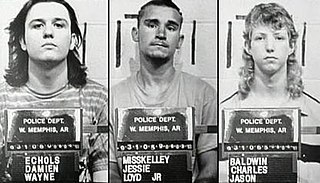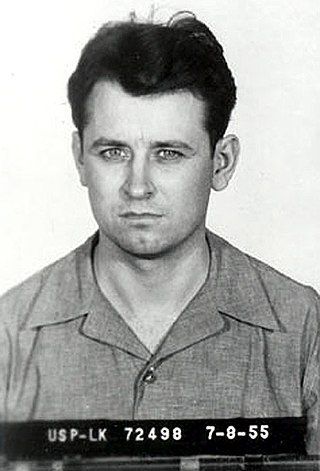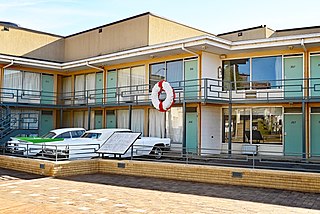
The West Memphis Three are three men convicted as teenagers in 1994 of the 1993 murders of three boys in West Memphis, Arkansas, United States. Damien Echols was sentenced to death, Jessie Misskelley Jr. to life imprisonment plus two 20-year sentences, and Jason Baldwin to life imprisonment. During the trial, the prosecution asserted that the juveniles killed the children as part of a Satanic ritual.

The Commercial Appeal is a daily newspaper of Memphis, Tennessee, and its surrounding metropolitan area. It is owned by the Gannett Company; its former owner, the E. W. Scripps Company, also owned the former afternoon paper, the Memphis Press-Scimitar, which it folded in 1983. The 2016 purchase by Gannett of Journal Media Group effectively gave it control of the two major papers in western and central Tennessee, uniting the Commercial Appeal with Nashville's The Tennessean.

The National Civil Rights Museum is a complex of museums and historic buildings in Memphis, Tennessee; its exhibits trace the history of the civil rights movement in the United States from the 17th century to the present. The museum is built around the former Lorraine Motel, which was the site of the 1968 assassination of Martin Luther King Jr. Two other buildings and their adjacent property, also connected with the King assassination, have been acquired as part of the museum complex.

The murder of Jodi Jones is a Scottish murder case from June 2003 in which a 14-year-old schoolgirl was murdered in woodland in Dalkeith, Scotland by her 14-year-old boyfriend Luke Mitchell. She was found murdered with a knife behind a wall on a path where she would invariably meet her boyfriend, having set out to meet him that afternoon.
Henry Dortress "Dickie" Marrow Jr. was an African-American veteran of the Army and known for being shot and killed by whites in a racial confrontation in Oxford, North Carolina, at the age of 23. His murder and the acquittal of two suspects by an all-white jury were catalysts for a renewal of civil rights actions in the county seat. Public facilities and businesses had remained segregated six years after passage of national civil rights legislation.
Henry Loeb III was an American politician of the Democratic Party, who was mayor of Memphis, Tennessee, for two separate terms in the 1960s, from 1960 through 1963, and 1968 through 1971. He gained national notoriety in his second term for his role in opposing the demands of striking sanitation workers in early 1968. A segregationist, he opposed civil rights for African Americans and promoted white supremacy, continuing former Memphis mayor and political boss E. H. Crump's legacy.

The Memphis sanitation strike began on February 12, 1968, in response to the deaths of sanitation workers Echol Cole and Robert Walker. The deaths served as a breaking point for more than 1,300 African American men from the Memphis Department of Public Works as they demanded higher wages, time and a half overtime, dues check-off, safety measures, and pay for the rainy days when they were told to go home.
Payne v. Tennessee, 501 U.S. 808 (1991), was a United States Supreme Court case which held that testimony in the form of a victim impact statement is admissible during the sentencing phase of a trial and, in death penalty cases, does not violate the Cruel and Unusual Punishment Clause of the Eighth Amendment. Payne narrowed two of the Courts' precedents: Booth v. Maryland (1987) and South Carolina v. Gathers (1989).

James Earl Ray was an American fugitive who was convicted of the assassination of Martin Luther King Jr. at the Lorraine Motel in Memphis, Tennessee, on April 4, 1968. After the assassination, Ray fled the United States and was captured in the United Kingdom. Ray was convicted in 1969 after entering a guilty plea—thus forgoing a jury trial and the possibility of a death sentence—and was sentenced to 99 years of imprisonment.

Martin Luther King Jr., an African-American clergyman and civil rights movement leader, was fatally shot at the Lorraine Motel in Memphis, Tennessee, on April 4, 1968, at 6:01 p.m. CST. He was rushed to St. Joseph's Hospital, where he died at 7:05 p.m. He was a prominent leader of the civil rights movement and a Nobel Peace Prize laureate who was known for his use of nonviolence and civil disobedience.
Echol Cole and Robert Walker were sanitation workers who died accidentally in Memphis, Tennessee at the corner of Colonial Rd. and Verne Rd. on February 1, 1968. While working that day, the pair sought refuge from a rainstorm in the compactor area of their garbage truck. The two African American men were prevented from seeking shelter from the rain inside a building due to segregation laws. They were killed when the compactor accidentally activated. Their deaths were a precursor to the Memphis sanitation strike, during which the prominent civil rights leader Martin Luther King Jr. was assassinated.

On the morning of September 4, 2005, six days after Hurricane Katrina struck New Orleans, members of the New Orleans Police Department (NOPD), ostensibly responding to a call from an officer under fire, shot and killed two civilians at the Danziger Bridge: 17-year-old James Brissette and 40-year-old Ronald Madison. Four other civilians were wounded. All the victims were African-American. None were armed or had committed any crime. Madison, a mentally disabled man, was shot in the back. The shootings caused public anger and further eroded the community's trust in the NOPD and the federal response to Hurricane Katrina overall.

Louis Allen was an African-American logger in Liberty, Mississippi, who was shot and killed on his land during the civil rights era. He had previously tried to register to vote and had allegedly talked to federal officials after witnessing the 1961 murder of Herbert Lee, an NAACP member, by E. H. Hurst, a white state legislator. Civil rights activists had come to Liberty that summer to organize for voter registration, as no African-American had been allowed to vote since the state's disenfranchising constitution was passed in 1890.

Clayborn Temple, formerly Second Presbyterian Church, is a historic place in Memphis, Tennessee, United States. It was listed on the National Register of Historic Places in 1979 for local architectural significance. It was upgraded to national significance under Clayborn Temple in 2017 due to its role in the events of the Sanitation Workers' Strike of 1968. The historic structure was sold to the A.M.E. Church in 1949, which named the building after their bishop.

The Tandragee killings took place in the early hours of Saturday 19 February 2000 on an isolated country road outside Tandragee, County Armagh, Northern Ireland. Two young Protestant men, Andrew Robb and David McIlwaine, were beaten and repeatedly stabbed to death in what was part of a Loyalist feud between the Ulster Volunteer Force (UVF) and their rivals, the breakaway Loyalist Volunteer Force (LVF). The men were not members of any loyalist paramilitary organisation. It later emerged in court hearings that Robb had made disparaging remarks about the killing of UVF Mid-Ulster Brigade leader Richard Jameson by an LVF gunman the previous month. This had angered the killers, themselves members of the Mid-Ulster UVF, and in retaliation they had lured the two men to the remote lane on the outskirts of town, where they killed and mutilated them.

Kenneth Chamberlain Sr. was fatally shot by police on November 19, 2011, in White Plains, New York. After his LifeAid medical alert necklace was inadvertently triggered, police came to his home and demanded that he open his front door. Despite his objections and statements that he did not need help, the police broke down Chamberlain's door. According to police, Chamberlain charged at them with a knife and he was tasered, and then fatally shot. Chamberlain was a 68-year-old, black, retired Marine, and a 20-year veteran of the Westchester County Department of Corrections. He wore the medical alert pendant due to a chronic heart problem.
Johnny Robinson (1947–1963) was a young African-American teenager who, at age 16, was shot and killed by a police officer in the unrest following the 16th Street Baptist Church bombing in Birmingham, Alabama. A Birmingham police officer, Jack Parker, who was riding in the back seat of a police car, shot and killed Robinson. Parker was never indicted for the killing.
The Loyd Jowers trial, officially the King family vs. Loyd Jowers and other unknown co-conspirators, was an American wrongful death civil suit brought by the family of Martin Luther King Jr. against Loyd Jowers, following his claims of a conspiracy in the assassination of the civil rights leader in 1968. The jury would eventually decide in 1999 that there was a conspiracy perpetrated by Jowers and other conspirators, including various United States government agencies, to murder King and frame James Earl Ray as a patsy.
Roman Ducksworth Jr. was a notable figure in American civil rights history, whose story reflects the struggle for racial equality during the violent era of the 1960s. He was shot and killed as a hate crime by Taylorsville, Mississippi police as he was heading to the hospital expecting his sixth child. His death is one of the many cases that exemplify the systemic racial violence and injustice prevalent in the United States, particularly in the South, during this period.

On May 27, 2020, after 11 a.m., a 38-year-old African-American transgender man, Tony McDade, was fatally shot in the Leon Arms apartment complex by an officer of the Tallahassee Police Department, following the fatal stabbing of Malik Jackson on nearby Saxon Street. Early reports of the incident misgendered McDade as a "woman", and on May 28, the police department described McDade as a woman who "identified as a man". On September 3, a Leon County grand jury found that the police use of force against McDade was justified. Police body camera showing McDade pointing a firearm at one of the police officers before being shot was also released.













